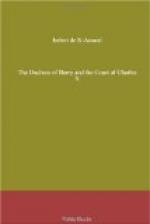Next come the entrees of the Cabinet (which must not be confused with the first entrees of the Cabinet). These give to persons enjoying them the right to enter that room usually a little before the hour fixed by the King to hear Mass, and to remain there at will during the day, up to the hour of the evening when the sovereign gives out the watchword. They belong to the grand officers and to the first officers of the civil and military households of the King, to the major-generals of the royal guard and the lieutenant-general in service, to the cardinals, to the Chancellor of France, to the minister-secretaries of State, to the Grand Chancellor of the Legion of Honor, to the marshals of France, to the Grand Referendary of the Chamber of Peers, to the President of the Chamber of Deputies, and to all the officers of the King’s household on service.
The persons and functionaries civil or military with a lower rank in the hierarchy of the court have their entrees, some to the Hall of the Throne, others to the first salon preceding the Hall of the Throne (the Salon d’Apollon under Napoleon III.), and still others to the second salon (communicating with the Hall of the Marshals, and called, under Napoleon III., the Salon of the First Consul).
The collective audience given to all having their entries was called the public audience of the King. It took place when the King went to hear Mass in his chapel, only on his return to re-enter his inner apartment. Followed by all his grand officers and his first officers in service, Charles X. passed to and paused in each of the rooms in his outer apartment, in order to allow those having the right to be there to pay their court to him. When he attended Mass in his inner apartment, he gave a public audience only after that ceremony. He paused in his Grand Cabinet, then in the Hall of the Throne, and successively in the other rooms.
When the King was ready to receive, the First Gentleman of the Chamber gave notice to the grand officers and the first officers that they might present themselves. Moreover, he placed before the King the list of persons having entrees to his apartments or to whom he had accorded them. On this list Charles X. indicated those he wished invited.
There was no titular Grand Equerry of France. The First Equerry, charged with the saddle-horses of the King, was the Duke of Polignac, major-general. The two equerries-commandant were the Marquis of Vernon and Count O’Hegerthy, major-general. There were, besides, four equerries, masters of the horse, three each quarter, namely: for the January quarter the Chevalier de Riviere, major-general; the Count Defrance, lieutenant-general; the Baron Dujon, major-general;—for the April quarter, the Colonel Viscount de Bongars; the Baron Vincent, major-general; the Viscount Domon, lieutenant—general;—for the July quarter, the Colonel Marquis de Martel, the Viscount Vansay, the Count Frederic de Bongars;— for the October quarter, the Count de Fezensac, major-general; the Colonel Marquis Oudinot, the Colonel Marquis de Chabannes. The chief Equerries of the stable were the Viscount d’Abzac and the Chevalier d’Abzac, both colonels. There were, besides, the equerries in ordinary and the pupil-equerries. The pages belonged to the service of the Grand Equerry of France.




